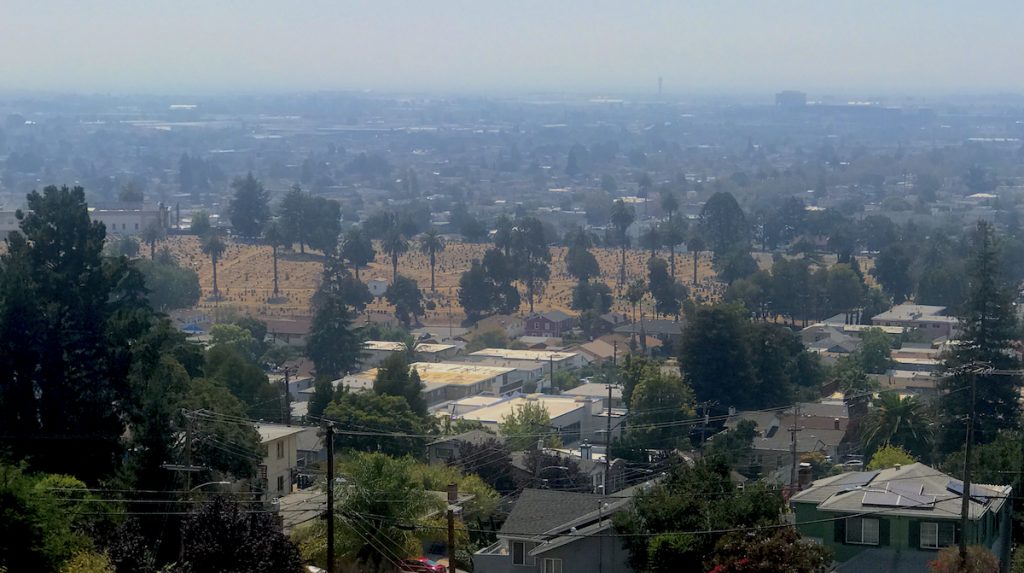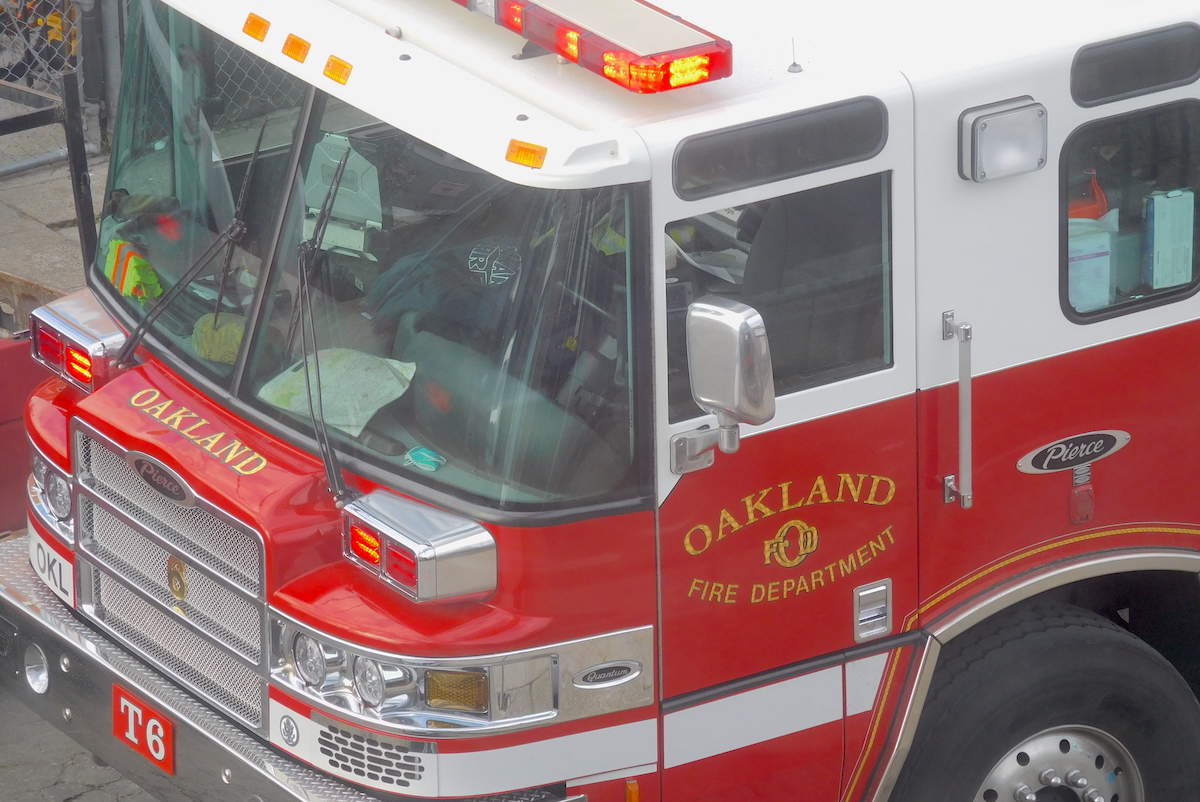
Thirty years ago, a small grass fire began in the Berkeley hills. Firefighters thought they extinguished it, but the next day the flames reappeared, grew to a massive size, rapidly crossed highways and borders into Oakland, and ended its path of destruction at the edge of Piedmont, killing 25 people and obliterating thousands of homes along the way.
These days, the terrain is drier, the air is hotter, and fires travel faster. If a tree in Oakland catches fire, Orinda, Kensington, or Castro Valley could easily be under threat.
“Wildfires go on a regional basis,” said Jon Kaufman, president of the Claremont Canyon Conservancy. He’s among a group of fire prevention advocates who say the multi-city problem demands a multi-city solution. They’re encouraging Oakland and numerous nearby jurisdictions to form a Wildfire Joint Powers Authority, a new regional governmental body that could create and implement an East Bay-wide plan to help residents prepare for or prevent the next big blaze.
The joint powers authority, or JPA, is just an idea right now, but advocates say it would consist of representatives from the cities and other agencies (like the East Bay Regional Parks District, East Bay Municipal Utility District, and UC Berkeley) included in the western portions of Alameda and Contra Costa counties that are considered by Cal Fire to be “high” or “very high fire hazard severity zones.” In Oakland, that’s the hills.
If the East Bay moves forward with the JPA plan, the agency’s specific duties will be hashed out in the coming months, but the idea is to form an entity that can devise a regional fire prevention plan, clearing hazardous vegetation in the forested areas and educating property owners on “home hardening” and creating “defensible space.”
Sue Piper, who lost her Hiller Highlands house in the 1991 firestorm and rebuilt it after, said there are many “different jurisdictions criss-crossing the neighborhood” where she lives, from the city of Oakland to the California Department of Transportation and the Oakland Unified School District, and each handles wildfire risk-mitigation on their respective properties, following different protocols.
“Nobody’s really coordinating it,” said Piper, who leads the Oakland Firesafe Council, an advocacy group. “A Joint Powers Authority would have consistent standards,” for example requiring and facilitating property inspections at the same frequency throughout the East Bay.
Right now, “you’re only as safe as the weakest link,” said Piper. Even if an individual homeowner or city does its due diligence, building with fire-safe materials or inspecting regularly, nobody will be protected if the neighboring residences or jurisdictions are overgrown with brush.
The idea of a Wildfire JPA has drawn endorsements from numerous elected officials, including Oakland Mayor Libby Schaaf and Councilmembers Dan Kalb and Sheng Thao, who represent the fire-prone hills.
Advocates are urging cities and agencies to pass an initial joint resolution this year, indicating interest in working together to explore the possibility of forming a JPA. That action would enable a multi-city committee to figure out exactly what the JPA would entail: who would serve on the board, how far its authority would extend, and, perhaps most critically, how it would be funded.
“I like the idea, but you can’t just say, ‘Let’s do it,’” said Kalb, who’s the councilmember for North Oakland, including the Upper Rockridge hills that were scorched in 1991. “There’s a big set of questions. Do you want to give this new JPA the authority to enact laws that all the jurisdictions have to abide by? Is each city going to have to fork over a million dollars?”

The JPA advocates say they’ve already raised $85,000, including a grant from the Bay Area Air Quality Management District, to support the initial discussions and formation of a JPA. And the authority itself could be a vehicle for large state and federal grants that individual agencies can’t currently access. But the ongoing operations of the JPA would require a sustainable funding source, such as a tax on residents in the affected areas or participating cities.
For years, Oakland had its own special wildfire-prevention assessment district, funded with a tax on homeowners in the hills, but the district was disbanded after voters failed to renew the tax in 2013. Some in the city want to bring it back, raising questions about how it would interact with the effort to fund a JPA.
Kalb noted that he was active in the creation of East Bay Community Energy—another regional agency formed recently, as an alternative to PG&E—but he pointed out that as an energy provider, EBCE has a built-in revenue source: the customers who pay their electricity bills.
But there’s a nearby example of an active JPA that raises money to handle wildfire prevention and emergency preparedness. Marin County has a new JPA supported by a voter-approved property tax in 2020. Its area of coverage overlaps with 19 separate, local fire agencies, but before the JPA was formed there was no entity coordinating prevention efforts among the towns.
Inspectors from the Marin Wildfire Prevention Authority work with local firefighters to conduct evaluations of homes throughout the region and issue reports for residents with recommendations on making their properties safer. An East Bay JPA would require more elaborate coordination, however, convening two counties instead of only one.
“What we have to figure out is exactly what the JPA would do,” said Kaufman. “Would it be involved in managing vegetation and cutting out invasive species, or would it simply be setting priorities and providing information to existing agencies? I think it would be ideal for the JPA to become an actual operating agency. The smaller cities don’t have the resources, the staffing, the knowledge, or the money to do this.”
For even the most resourced and experienced, “wildfire prevention” can seem like a futile task or a contradiction in terms. Some of the recent mega-fires have surprised long-time firefighters, behaving in unusual ways, thwarting traditional firefighting methods, for example by traveling rapidly downhill. But Piper said there are still concrete steps that individuals and governments can take to significantly reduce the risk of damage.
“Fire needs three things,” she said. “Fuel, weather, and topography. You can’t do anything about topography and you can’t do much about the weather, but you can do something about fuel.”
“Fuel” includes houses and plants. In recent years, best practices have developed around “hardening” your home—covering vents so embers can’t get in, for example, or installing double-paned windows that won’t shatter from heat. Experts also tell homeowners to create “defensible space,” or buffers between flammable vegetation and their houses, such as by clearing dead plants and moving firewood away from the property.
While the state requires property owners in fire-prone areas to maintain defensible space—of 100 feet, in High Fire Hazard Severity Zones— the law often goes unfollowed or unenforced. In 2019, the Oakland Firesafe Council surveyed dozens of fire departments and community councils across the state, studying the effectiveness of their defensible space programs. The consultant who conducted the study found that the Oakland Fire Department “moderately enforces” residential vegetation management, inspecting every property annually.
“Many programs indicate that the most effective aspect of their program is some form of outreach and education, including community meetings and other face-to-face interactions with inspectors,” the study found. Survey respondents also said cost was the biggest barrier to complying with the law.
JPA advocates hope the new agency can address these obstacles, bringing in funds to help residents harden their homes and improving education across the region. Many of the current Oakland and Berkeley hills residents moved to the East Bay long after the 1991 firestorm, Piper noted, and may be less compelled to invest in fire prevention than their neighbors who endured the trauma of the blaze, and went through the trouble of rebuilding.
“We want people to understand that we are still at great risk,” she said. “I don’t want anyone else to go through that.”
Correction: A previous version of this story said that JPA advocates have raised $85 million. They’ve raised $85,000.
